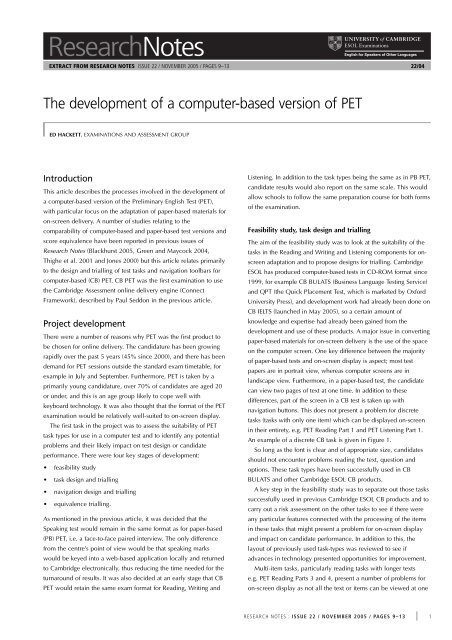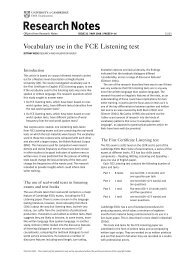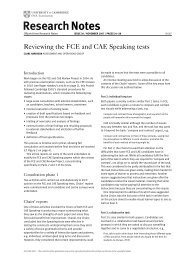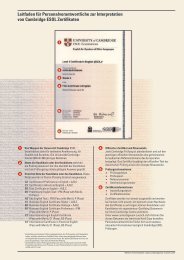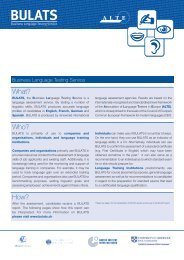ResearchNotes - Cambridge English Exams
ResearchNotes - Cambridge English Exams
ResearchNotes - Cambridge English Exams
You also want an ePaper? Increase the reach of your titles
YUMPU automatically turns print PDFs into web optimized ePapers that Google loves.
<strong>ResearchNotes</strong>EXTRACT FROM RESEARCH NOTES ISSUE 22 / NOVEMBER 2005 / PAGES 9–13 22/04The development of a computer-based version of PET|ED HACKETT, EXAMINATIONS AND ASSESSMENT GROUPIntroductionThis article describes the processes involved in the development ofa computer-based version of the Preliminary <strong>English</strong> Test (PET),with particular focus on the adaptation of paper-based materials foron-screen delivery. A number of studies relating to thecomparability of computer-based and paper-based test versions andscore equivalence have been reported in previous issues ofResearch Notes (Blackhurst 2005, Green and Maycock 2004,Thighe et al. 2001 and Jones 2000) but this article relates primarilyto the design and trialling of test tasks and navigation toolbars forcomputer-based (CB) PET. CB PET was the first examination to usethe <strong>Cambridge</strong> Assessment online delivery engine (ConnectFramework), described by Paul Seddon in the previous article.Project developmentThere were a number of reasons why PET was the first product tobe chosen for online delivery. The candidature has been growingrapidly over the past 5 years (45% since 2000), and there has beendemand for PET sessions outside the standard exam timetable, forexample in July and September. Furthermore, PET is taken by aprimarily young candidature, over 70% of candidates are aged 20or under, and this is an age group likely to cope well withkeyboard technology. It was also thought that the format of the PETexamination would be relatively well-suited to on-screen display.The first task in the project was to assess the suitability of PETtask types for use in a computer test and to identify any potentialproblems and their likely impact on test design or candidateperformance. There were four key stages of development:• feasibility study• task design and trialling• navigation design and trialling• equivalence trialling.As mentioned in the previous article, it was decided that theSpeaking test would remain in the same format as for paper-based(PB) PET, i.e. a face-to-face paired interview. The only differencefrom the centre’s point of view would be that speaking markswould be keyed into a web-based application locally and returnedto <strong>Cambridge</strong> electronically, thus reducing the time needed for theturnaround of results. It was also decided at an early stage that CBPET would retain the same exam format for Reading, Writing andListening. In addition to the task types being the same as in PB PET,candidate results would also report on the same scale. This wouldallow schools to follow the same preparation course for both formsof the examination.Feasibility study, task design and triallingThe aim of the feasibility study was to look at the suitability of thetasks in the Reading and Writing and Listening components for onscreenadaptation and to propose designs for trialling. <strong>Cambridge</strong>ESOL has produced computer-based tests in CD-ROM format since1999, for example CB BULATS (Business Language Testing Service)and QPT (the Quick Placement Test, which is marketed by OxfordUniversity Press), and development work had already been done onCB IELTS (launched in May 2005), so a certain amount ofknowledge and expertise had already been gained from thedevelopment and use of these products. A major issue in convertingpaper-based materials for on-screen delivery is the use of the spaceon the computer screen. One key difference between the majorityof paper-based tests and on-screen display is aspect; most testpapers are in portrait view, whereas computer screens are inlandscape view. Furthermore, in a paper-based test, the candidatecan view two pages of text at one time. In addition to thesedifferences, part of the screen in a CB test is taken up withnavigation buttons. This does not present a problem for discretetasks (tasks with only one item) which can be displayed on-screenin their entirety, e.g. PET Reading Part 1 and PET Listening Part 1.An example of a discrete CB task is given in Figure 1.So long as the font is clear and of appropriate size, candidatesshould not encounter problems reading the text, question andoptions. These task types have been successfully used in CBBULATS and other <strong>Cambridge</strong> ESOL CB products.A key step in the feasibility study was to separate out those taskssuccessfully used in previous <strong>Cambridge</strong> ESOL CB products and tocarry out a risk assessment on the other tasks to see if there wereany particular features connected with the processing of the itemsin these tasks that might present a problem for on-screen displayand impact on candidate performance. In addition to this, thelayout of previously used task-types was reviewed to see ifadvances in technology presented opportunities for improvement.Multi-item tasks, particularly reading tasks with longer textse.g. PET Reading Parts 3 and 4, present a number of problems foron-screen display as not all the text or items can be viewed at oneRESEARCH NOTES : ISSUE 22 / NOVEMBER 2005 / PAGES 9–13 | 1
Figure 1:CB PET Reading Part 1Figure 2:CB PET Reading Part 2time. Earlier <strong>Cambridge</strong> ESOL CB tests used pagination, clicking toturn to a new page, to overcome this problem, but most websitesnow use scrolling to move through text. Given the linearrelationship between questions and text, i.e. question 1 relating tothe first piece of text and question 2 to the next piece of text,it was felt that either procedure could work, so it was decidedthat both methods should be trialled to elicit a preference.One reading task, Reading Part 2, was highlighted as a potentialrisk. This is a multiple matching exercise in which the candidatehas to match five descriptions to one of eight short texts. In the PBtest, both text and items are displayed on a double A4 pagespread, so the candidates are able to read the questions and textsin any order and check references in one text against anothersimultaneously. Various options for display were looked into,including the separate scrolling of both questions and texts.However, designs for double scrolling were found to be toocomplex, leaving single scrolling or pagination options to betrialled. Figure 2 shows the computer-based version of ReadingPart 2.For the Writing section, the key issues were the impact of typingon candidate performance, and the effect of type-written script onexaminer marking; i.e. do examiners treat typed script moreharshly or leniently than handwritten script? A number of studiesinto this area have been carried out for CB IELTS (Thighe et al.2001, Green and Maycock 2004), but given the different testformat and candidature, it was agreed that further validationstudies would be carried out for CB PET. In the Listeningcomponent, the main concern was over Part 3, a gap-fillingexercise. Whilst most people can listen and takes notessimultaneously, it was felt that some candidates at this level maystruggle to listen and type their answers at the same time, and thatit may be necessary to allow students to make notes first, and thentype in their answers.Task trialling was carried out with a mixed nationality groupRESEARCH NOTES : ISSUE 22 / NOVEMBER 2005 / PAGES 9–13 | 2
of students preparing for PB PET in March 2004. Feedback fromtrialling was positive, with few problems being encountered by thestudents. Scrolling was found to be more popular than paginationas a method of moving through text, and black font on a bluebackground the favoured colour option for text and questions;as opposed to black on white, or white on blue. Reading Part 2appeared to present few problems in scrolling format with onequestion on-screen at a time. It may be that restricting the numberof questions a candidate can read at one time actually engenders amore efficient reading process and it is hoped that further researchinto the mechanics of reading on-screen versus on paper can becarried out in future. In writing, a preference for seeing questionsone at a time was expressed for Part 1, and most candidates foundtyping as easy or easier than having to write by hand in Parts 2and 3. In the listening section, candidates preferred the option ofseeing all the questions at one time and a number of candidatesexpressed a desire to make notes first then type in Part 3.Navigation design and triallingOnce task templates had been trialled and designs modified, thenavigation system was developed more fully. The main aim in thedevelopment of the on-screen navigation toolbars was to allowcandidates to progress through the test as they would in the PBformat, choosing which questions to answer first and being able toreturn to questions at any time during the test. The design teamdrew heavily on standard navigation toolbars and practices usedon websites. The main navigation was positioned at the bottom ofthe page, listing all parts of the test and this also indicated whichquestions had been answered. In addition to this, a part or subnavigationwas positioned above each task being attempted. Thisallowed easy navigation between the questions in a particular partof the test. Finally, a ‘next’ button appeared each time a questionwas answered, allowing candidates who wished to progressthrough the test in question order to do so. Figure 3 shows anextract from the CB Listening paper.Navigation trialling was tested on a mixed-nationality group ofCommon European Framework A2/B1 level students from a UKlanguage school in April 2004. These students were not on a PETpreparation course, as it was felt that if non-PET candidates withlittle or no knowledge of the test format were able to successfullynavigate through the test, this should not present a problem for realPET candidates. Results of navigation trialling were veryencouraging, with all candidates being able to work their waythrough the test without instruction. A few candidates hadproblems with Reading Part 2, but in the focus group it emergedthat they were unfamiliar with this task type. It also emerged thatthe rubric was not always being read, possibly due to the fact thatit was of less prominence than on the PB test. The rubric box wasredesigned with a clearer border and a shaded background tomake it stand out more.Despite the relative ease with which candidates navigatedthrough the test, it was agreed that both components: Reading andWriting, and Listening, would contain a brief tutorial, available tocandidates prior to starting the main test screen. One further aspectto arise out of navigation trialling was that some candidatesexpressed a wish to erase earlier answers, a function which theresponse buttons did not allow, as once selected they could beswitched to another answer, but not cleared. This functionality wasadded to the system ahead of equivalence trialling.Equivalence triallingEquivalence trialling took place in February 2005 with 190candidates at selected centres in Ireland (with Spanish speakingFigure 3:CB PET Navigation LayoutRESEARCH NOTES : ISSUE 22 / NOVEMBER 2005 / PAGES 9–13 | 3
students), Italy, Switzerland and the United Arab Emirates. Themain aim of this phase of trialling was to establish equivalencebetween PB PET and CB PET, though this was also anotheropportunity to road-test task and navigation design andfunctionality. Candidates participating in trialling also took a paperbasedanchor test, and were scheduled to enter for the paper-basedMarch PET session. Analysis of results found a predicted level ofscore gain from the CB test to the PB test, taken 6–8 weeks later.Earlier studies in CB/PB equivalence (Jones 2000, Green andMaycock 2004, Blackhurst 2005) found no significant difference toscores gained on different formats of BULATS and IELTS tests, andit is anticipated that this pattern will be reflected for CB PET.Equivalence trialling also gave a further opportunity to test therobustness of the online delivery engine and to get additionalcandidate reaction to task design and navigation usability. Allcandidates completed a questionnaire and a number of candidateswere asked to participate in post-test focus groups. The vastmajority of candidates rated the test navigation easy to use, with96% giving ratings of 3 or above on a scale of 1 to 5, where 5indicates total agreement. A number of specific questions relatingto candidates’ reactions to reading, writing and listening oncomputer were asked in order to gauge the general suitability oftaking a test on computer as opposed to on paper. In response tothe question ‘Did you find reading on computer easier thanreading on paper?’ 46% found it easier, whereas only 25%preferred reading on paper. This perhaps reflects an increasingfamiliarity with on-screen reading, at home, in school or at work.Typing written answers on computer was significantly morepopular than writing by hand, with 67% showing a preference fortyping and only 25% expressing a preference for handwriting.Listening was even more popular on computer, with 87%expressing a preference for listening individually on computer tolistening as a group from a CD or cassette player. This is probablynot surprising, as listening through headphones, with the ability toadjust the volume to your desired level, is a more personalexperience. The response method chosen in Listening Part 3,where candidates have to type in a one or two-word answer, wasof particular interest. Candidates were given the option of typing asthey listened, or listening and making notes on paper, then typingin their answer. Two minutes were allowed at the end of the partfor this. Responses were fairly evenly matched, with 42% claimingto have typed as they listened and 53% saying that they madenotes then typed in their answers.Overall, a preference for taking PET on computer was expressedby the majority of candidates. 63% preferred taking the Readingand Writing test on computer, as opposed to 20% preferring thepaper-based version. For the Listening test, 83% expressed apreference for the computer version, with only 4% preferring thepaper test. These results were backed up by comments made bycandidates in the focus groups. Whilst there was generalsatisfaction with the screen layout and navigation toolbars, a fewcandidates expressed a desire to be able to use a highlighting toolin the reading section, mirroring the function of underlining text onpaper. The technology required to enable this function is currentlybeing investigated for a future release of the software. Somecandidates also expressed a desire to be able to control the start ofeach part of the Listening test. However, whilst it would bepossible to cut up the sound files by part, this would removeequivalence of format with the paper-based test. In addition tomeasuring any impact on task difficulty, problems would arise oversetting a maximum time for the length of pause between differentparts and for the test itself.ConclusionEarly indications are that CB PET appears to be well suited to asizeable proportion of the PET candidature and it is anticipatedthat it will become increasingly popular with centres looking forgreater flexibility and faster turnaround times. However, it isappreciated that not all centres are equipped to deliver computerbasedproducts and some candidates will still prefer to take thepaper-based version, so CB PET has been developed as anadditional service rather than a replacement for traditional PB PETsessions. CB PET is being launched with a small number ofEuropean based centres in November 2005, prior to a widerword-wide rollout from March 2006.ReferencesBlackhurst, A (2005) Listening, Reading and Writing on computer-basedand paper-based versions of IELTS, Research Notes 21, 14–17.Green, A and Maycock, L (2004) Computer-based IELTS and paper-basedIELTS, Research Notes 18, 3–6.Jones, N (2000) BULATS: A case study comparing computer-based andpaper-and-pencil tests, Research Notes 3, 10–13.This is an extract from Research Notes, published quarterly by University of <strong>Cambridge</strong> ESOL Examinations.Previous issues are available on-line from www.<strong>Cambridge</strong>ESOL.org© UCLES 2005 – this article may not be reproduced without the written permission of the copyright holder.RESEARCH NOTES : ISSUE 22 / NOVEMBER 2005 / PAGES 9–13 | 4


